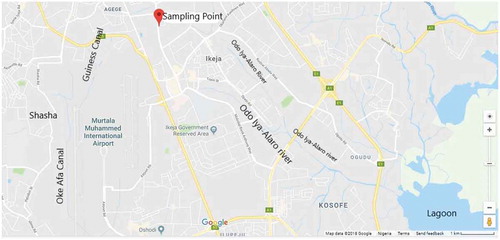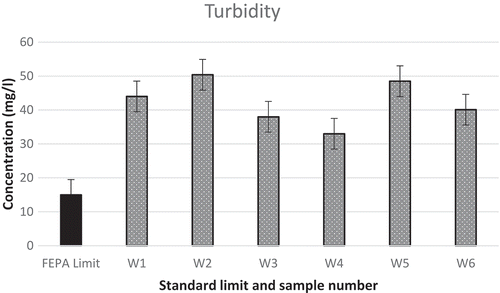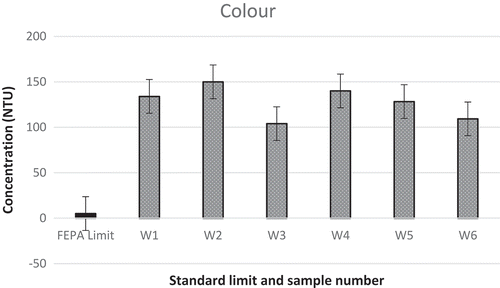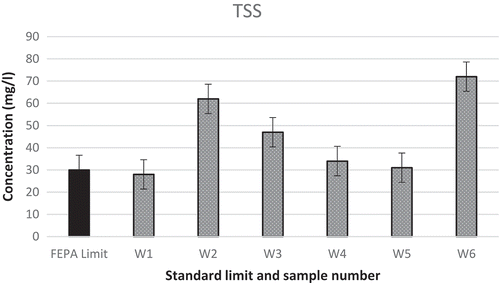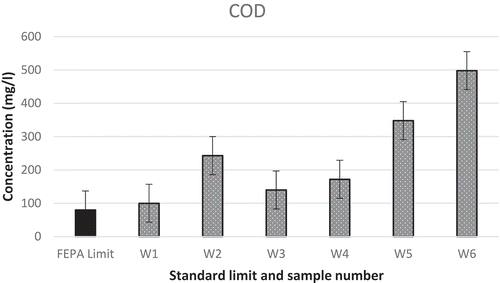Abstract
The quality of effluent from a wool and synthetic textile manufacturing company in Nigeria was examined by obtaining triplicate samples per week over a 6-week period. This was done to measure the waste-load and volumefrom the textile industry. Obtained samples were analyzed for 18 physicochemical parameters such as pH, color, turbidity, total suspended solids, total dissolved solids (TSS), conductivity, dissolved oxygen, biochemical oxygen demand (BOD), chemical oxygen demand (COD), chloride, nitrates, phosphates, some heavy metals and odor. Heavy metals, phosphate, and color were analyzed using spectrophotometer while dissolved oxygen and BOD were analyzed using azide modification method. The effluents were found to pass the national standard for the effluent limit for 13 parameters but exceeded specified limits for pH in one sample and, COD, TSS, color, turbidity and odor in all samples. Turbidity was found to exceed national limits by 100 to 300%; COD exceeded limits by 20% to 500%; TSS exceeded limits by 10% to 110% in 5 out of 6 samples analyzed. All obtained samples were dark colored and exceeded prescribed limits by 2,000 to 3,000% in all samples. Likewise, all six samples had an offensive odor. It was recommended that strict compliance with stipulated standards was necessary for the protection of public health and the environment.
Public Interest Statement
Wastewater discharge management has been a major subject in water research. The sample collection was done in an industrial environment of the Southwestern part of Nigeria. The wastewater samples were gotten from a textile industry discharge source (point source). The water quality parameters such as pH, colour, turbidity to mention but a few, were tested and compared with local surface water disposal limits. It was evident in the study, that strict compliance policies should be maintained for sustainability of the aquatic environment.
1. Introduction
Industrialization has been an important driver of economic development in most developing nations. It has provided much-needed jobs and improved livelihood for the ever-growing populations, especially in sub-Sahara Africa (Ogunkunle, Mustapha, Oyedeji, & Fatoba, Citation2016). However, development through industrialization carries a price tag. One such cost of industrialization includes environmental degradation through waste discharge (FEPA, Citation1991; Oketola & Osibanjo, Citation2009). Another downside to industrialization is the encouragement of rural-urban migration which leads to growing peri-urban centers and their attendant waste generation issues (Omole, Ndambuki, & Osabuohien, Citation2014). Lagos State in Nigeria is arguably the most populated and fastest growing City-State in Africa (Oketola & Osibanjo, Citation2009; Omole & Ndambuki, Citation2014). With a population of over 21 million people, density of over 5,870 persons per square kilometer, growth rate of 3.2%, and rural-urban ratio of 10:90, Lagos State represents the melting pot of Nigeria which is the most populous black nation on earth (Omole & Isiorho, Citation2011; Omole & Ndambuki, Citation2014). Aside from its huge population, Lagos State is also home to about 70% of all industries in Nigeria (Omole & Isiorho, Citation2011). The industries, by sectoral classification, include food, beverages, and tobacco; chemicals and pharmaceuticals; metals and alloys; textiles and fabrics; electrical and electronics; pulp and paper; plastics; foam and asbestos; among others (FEPA, Citation1999; Oketola & Osibanjo, Citation2009; Omole & Isiorho, Citation2011).
According to an analysis conducted by Oketola and Osibanjo (Citation2009), the textile industry is the second highest polluting industry in Lagos State, next to chemical and pharmaceutical industries, with respect to release of toxic chemicals into the environment. Textile industries typically discharge high volumes of highly concentrated toxins into the environment (Holkar, Jadhav, Pinjari, Mahamuni, & Pandit, Citation2016; Jegatheesan et al., Citation2016). Depending on the end product, textile effluents may have extreme concentrations of chemical oxygen demand (COD), biochemical oxygen demand (BOD), pH, heavy metals, color, turbidity, enzymes, waxes, solvents, soaps, sodium chloride, fats, oils, suspended solids, sulphide and temperature, among other contaminants (FEPA, Citation1999; Holkar et al., Citation2016; Jegatheesan et al., Citation2016). Also, Mohan, Balasubramanian, and Basha (Citation2007) reported that each kilogram of textile product results in the discharge of 100–170 L of toxic chemical-laden wastewater. Due to the high flow of wastewater, most textile manufacturing companies discharge their effluent into nearby water bodies where the toxins can potentially and adversely affect aquatic life, fresh water supplies, and ultimately, public health. Some of the reported effects of textile effluent on humans include skin irritations, allergic reactions, cancer, inhibited sperm motility and respiratory difficulties (Oktav Bulut & Akar, Citation2012). Oktav Bulut and Akar (Citation2012) further warned that although processes involving the use of natural dyes are slightly more expensive than synthetic dyes, the natural dye does not contain carcinogens and other harmful toxins, unlike synthetic dyes.
The release of toxic chemicals into the environment in Lagos State (and most parts of Nigeria) is worrisome because an estimated 80% of the industries release their process wastewater without any form of pre-treatment (FEPA, Citation1999; Mohan et al., Citation2007; Omole & Isiorho, Citation2011). The polluters do this brazenly because the laws governing the quality of effluent prior to discharge into the environment are weak and half-heartedly enforced (Omole, Isiorho, & Ndambuki, Citation2016). Adedeji and Ako (Citation2009) inferred that government had tacitly prioritized economic advantages over environmental protection. In a country where unemployment rate spikes as high as 60%, it does not require much to decipher reasons why the highest punishment for environmental pollution under the Lagos State Environmental Sanitation Law amounts to just three months imprisonment or an option of fine of 4,000 Naira ($11 USD) (Adedeji & Ako, Citation2009). Adedeji and Ako (Citation2009) further reported that no firm had been successfully prosecuted based on this law, despite repeated complaints from residents, simply because the firms have more funds at their disposal to acquire the best legal representations and to defer court rulings indefinitely. Also in an environment where majority of the citizens do not have access to piped water service for domestic use but have to source water from dug wells and surface water bodies (Mohan et al., Citation2007; Oktav Bulut & Akar, Citation2012), the citizens could be viewed as the ultimate victims of the environmental pollution activities. Due to the various complaints by domicile populace in the industrial axis of Ikeja, this study is aimed at measuring the various physicochemical parameters of the water body around that axis. The significance of water on human health cannot be over emphasized. Therefore, this current study assessed the quality of wastewater emanating from a synthetic textile manufacturing industry in Lagos and its potential impact on the environment and public health.
2. Materials and methods
2.1. Study area
The samples for this study were obtained from the outfall of a textile manufacturing industry situated along Oba Akran road in Ikeja, Lagos State, Nigeria. The textile industry manufactures woolen and synthetic materials. The textile manufacturing process involves sizing suspension, scouring, bleaching and dyeing (FEPA, Citation1991). The industry’s wastewater is discharged into a rectangular-shaped concrete channel which ultimately empties into Odo Iya-Alaro, a natural stream, several kilometers away (Figure ). The same river receives wastewater from hundreds of other industries. Ikeja Local Government Area accommodates three out of the fourteen industrial estates in Lagos. They are Ikeja, Agidingbi and Oregun (Oketola & Osibanjo, Citation2009). The other 11 industrial estates are situated in Amuwo Odofin, Apapa, Gbagada, Iganmu, Ijora, Ilupeju, Matori, Ogba, Oshodi-Isolo, Surulere and Yaba areas of Lagos State (Oketola & Osibanjo, Citation2009). Hundreds of such industries operate from these planned estates and discharge their varied effluents in a web of canals all around Lagos State (Adedeji & Ako, Citation2009; Oketola & Osibanjo, Citation2009; Olowu et al., Citation2010). These canals empty into natural channels which ultimately transport the wastewater to any of the six flood drains in Lagos State (Adegun, Odunuga, & Appia, Citation2015). The industries around Ikeja, however, drain into Shasha River and Odo Iya-Alaro, which in turn empty into the lagoons (Figure ). As a coastal city-State with low elevations, Lagos is susceptible to high run-off and frequent flooding (Omole & Isiorho, Citation2011). Thus, the plethora of wastewater arising from the industrial activities in the State is a major factor in the city’s consideration for run-off management.
2.2. Sampling and laboratory analysis
The samples were obtained at a point source outside the industry’s premises where effluent is discharged into rectangular channel drains. Triplicate samples were collected on each sampling date (at six hours interval—morning, afternoon, and evening). This was done once per week, over a period of six weeks. The effluent samples were consistently dark brown to black in coloration over the sampling period and emitted a pungent odor.
Sterilized plastic bottles were used for collecting the effluent samples. The wastewater from the sampling point source was allowed to flow freely for 2–3 min before the bottles were rinsed thrice with the effluent. Subsequently, the effluent was collected into the bottles. Each bottle was labeled according to sampling time and date. The pH and temperature of the effluents were determined in-situ. The pH of the wastewater samples was determined at the point of sampling using pH meter (model Jenway 3310, Staffordshire, United Kingdom) after the pH electrode had been calibrated using buffers of pH 4.0, 7.0 and 10.0. The electrode was immersed in the wastewater sample and reading was recorded. The temperature was determined using a thermometer, while conductivity was determined using a conductivity meter (Hach model C0150, Colorado, United States). All physicochemical parameters and heavy metals were determined at Triple E Systems Associates limited, Ikorodu road, in Lagos. All samples were analyzed as described in the standard methods for the examination of water and wastewater (APHA, AWWA, and WEF, Citation2005). Total suspended solids (TSS) and Total dissolved solids (TDS) were determined by measuring 100 ml of well-mixed sample into a dry evaporating dish at 103°C-105°C for an hour. The substance was then evaporated to dryness in a water bath. The dish was transferred to an oven and dried to a constant weight at 105°C. Following removal from the oven, the dish was allowed to cool in a desiccator and re-weighed. This process of drying, cooling and weighing was continued until a constant weight was obtained.
Dissolved oxygen (DO) and BOD were determined by sodium azide modification of Winkler method, after appropriate dilutions. The COD was determined by the dichromate digestion method, nitrates were determined using the indophenol colorimetric method. Chloride was determined using argentometric titration method. Phosphate and color, as well as copper, zinc, iron, cadmium and manganese, were determined using Perkin- Elmer ASS-280 Flame Atomic Absorption Spectrophotometer. All the reagents used for the analysis were of analytical grade and provided by Triple E Systems Associates limited. The analysis was conducted on each sample and the mean values were obtained. The laboratory data obtained were input to Microsoft Excel spreadsheets, from where descriptive statistics such as range, mean deviation, variance, standard deviation, and standard error were computed. All physicochemical parameter results were compared with the national standard effluent limit as specified in the Federal Environmental Protection Agency (FEPA) guidelines (FEPA, Citation1991, Citation1999). Also, a comparative study of the current research and those of reported textile effluent concentrations from four other industries situated in Lagos and Kaduna States (FEPA, Citation1991) was done.
3. Results and discussion
Results of both in-situ and laboratory experiments conducted to obtain the physicochemical parameters of the textile industry effluent are presented in Table . The National limit for textile industry effluent for each parameter is displayed in column 9 of Table . The National Standard document (FEPA, Citation1991) also presented effluent concentrations (T1-T4) from four other textile industries in other locations within Nigeria (Table ). Also indicated in Table are results of water samples from streams (S1-S4) which were impacted by effluent from textile industries. Table helps to give perspective to the results obtained for the current study.
Table 1. Laboratory results of the physicochemical parameters and heavy metals
Table 2. Mean pollutant concentration from current study compared to four other textile industries (T1-T4) and four stream samples (S1-S4) from previous studies in Nigeria (FEPA, Citation1991 )
An inspection of the results indicates that out of the 18 parameters tested, the effluents were below the National effluent standard limit for 13 parameters in all samples but exceeded the stipulated limits for pH, turbidity, color, total suspended solids and chemical oxygen demand (COD) in some or all the samples (Table ). The pH in five of the six samples was within the standard effluent limits except in week 5 where it exceeded the limits marginally with a value of 9.42. The textile effluents were generally alkaline in nature (Table ).
3.1. Turbidity
Results indicate that all the wastewater samples exceeded the stipulated standard limit for textile industry effluents by as much as 100% to 300% (Figure ). The continuous discharge of this high volumeand highly turbid wastewater has the potential to degrade the receiving stream (Odo-Iya Alaro) and ultimately, Lagos Lagoon which is the final destination (Figure ). The Lagos Lagoon itself is the habitat of nearly 100,000 peri-urban dwellers who live and fish on the lagoon (Simon, Adegoke, & Adewale, Citation2013). Turbidity from textile wastewater can be caused by colloidal substances obtained from colouring, dyeing, and waxing activities (Elango & Elango, Citation2017; WHO, Citation2017). Turbidity, as a physical contaminant, has the potential to hinder photosynthesis of organisms with the potential for phytoremediation of polluted water bodies (Elango & Elango, Citation2017). It can also protect microbes from the effects of disinfectants (WHO, Citation2017).
3.2. Color
Color contamination from the all the samples exceeded prescribed limits by as much as 2000% to 3000% (Figure ). Color is measured in parts per million of platinum cobalt to water (Ptco) as specified by APHA, AWWA, and WEF (Citation2012) with distilled water (color value of zero) forming the baseline. Color contamination of freshwater water bodies by wastewater is a major problem that has the potential to destroy the aesthetic values of adjoining properties and degrade landscapes and domestic water supply sources. Color also impedes the photosynthetic processes of aquatic life (Elango & Elango, Citation2017). Lagos has 787 km2 of water bodies (accounting for 22% of its total area) (Omole & Isiorho, Citation2011). This gives the State aquatic splendor with great views for tourists. However, large portions of these water bodies are being degraded and messed up by wastewater colored discharges (Adegun et al., Citation2015; Adedeji & Ako, Citation2009). This problem could ultimately lead to revenue loss for the State.
3.3. Total suspended solids
Except for samples obtained in Week 1, all other samples exceeded the stipulated standard limit for total suspended solids (TSS) (Figure ). Suspended solids can be described as solid pollutants that float on a liquid or suspended in liquid, sewage or wastewater (FEPA, Citation1991). Total suspended solids in textile wastewater can be caused by precipitates and other compounds such as chlorides, carbonates, bicarbonates, magnesium, sodium, calcium, potassium and other salts which are used for in the textile manufacturing processes (Elango & Elango, Citation2017).
3.4. Chemical oxygen demand
The chemical oxygen demand (COD) of effluent from the sampled textile industry exceeded the stipulated limit in all analyzed samples by 20% to 500% (Figure ). This parameter is indicative of the quantity of oxygen required to break down the chemical pollutant in the water body. In extreme cases, oxygen is completely depleted from the water body and consequently, no freshwater organism can survive. COD in textile wastewater can be caused by formaldehyde based dyes, softeners and detergents (Elango & Elango, Citation2017).
3.5. Comparison of samples with textile effluents from other industries
Table shows that the mean pH of 7.7 from the Ikeja textile industry is mild compared with samples from T1-T3 which were more alkaline. The only T4 from a Kaduna textile factory had a value less than the Ikeja study. Similarly, water samples (S1-S4) obtained from streams that serve as sinks for textile industry effluents showed that 50% of the samples from the streams were highly alkaline at pH greater than 11.0 (S2 and S4).
The color of three samples from the receiving streams (S2-S4) was far worse than the mean value of the color of the effluent obtained from Ikeja. This further goes to confirm that textile industries have high contributions in discoloring surface water bodies through effluent discharge. Often, color contamination in industrial wastewater can be pre-treated with adsorptive materials which are readily available in commercial quantities (Jain, Kumar, & Hayssam Izazy, Citation2009; Popuri, Mandapati, Pagala, & Guttikonda, Citation2016).
Although the limit for conductivity (or electrical conductivity) was not specified in the National Effluent Standards, high conductivity is indicative of the presence of dissolved solids or salts in water or wastewater. The National Standard for drinking water quality, however, specifies a limit of 1000 us/cm (SON, Citation2007). The mean value of 253 mg/L from the sampled effluent at Ikeja there indicates mildness and was far less than most obtainable from other textile industries and receiving streams which were as high as 3,300 in S4 (Table ). Similarly, available concentration values for BOD, chlorides and manganese in the other textile and river water samples in Table exceeded the average value from the textile industry at Ikeja. The COD values T2 and T4 (Table ) were also higher in comparison to the mean COD of the textile industry at Ikeja, thus lending credence to the fact that COD is a major potential problem arising from insufficiently treated textile industry wastewater.
4. Conclusion
The study of effluent samples from a textile industry located at Oba Akran Road, Ikeja suggests that some form of pre-treatment is being embarked upon within the premises before discharge into the environment. This was inferred from the fact that out of the 19 parameters checked for (Table ), the effluent from this industry surpassed specified national standard limit in just five parameters namely pH, COD, TSS, color and turbidity. Typical indicators of untreated textile industry effluent often have extreme values of pH, COD, BOD, turbidity, temperature, chlorides, conductivity and heavy metals. Some of these extreme values were sourced from data on other textile industries in Nigeria, as published by the environmental regulatory body (FEPA, Citation1991). When these values were compared to values from the Ikeja industry, it was observed that the contaminant level was milder when placed in context. However, this does not overrule the need for the textile industry under study to improve on its effluent quality. The national regulatory body (National Environmental Standards and Regulations Enforcement Agency, NESREA, which metamorphosed from FEPA in 2008) should insist on 100% compliance of all industries with all effluent quality standards. This is necessary because any of the physicochemical parameters which may appear harmless could be environmentally degrading and expensive in terms of opportunity costs. For instance, Odo-Iya Alaro, the receiving stream for the effluent from the textile industry at Oba-Akran and other neighboring industries effluents is a highly degraded river which traverses long distances within Lagos. Documented reports indicate the river is odorous and dark in coloration as a result of effluent discharges from the numerous industrial activities along its path (Adegun et al., Citation2015). To protect its freshwater bodies and aesthetic and tourist attraction values, Lagos State needs to insist on high levels of effluent quality from all industries within its domain. Also, there is documented evidence that 2.72% of Lagos residents depend on surface water bodies for domestic water and 63 % on groundwater (Omole, Ndambuki, Badejo, Oyewo, & Soyemi, Citation2016). Since all hydrological systems are connected, there is a high probability that pollutions from surface water sources could impact the groundwater sources. Besides, the near hundred thousand people who live on stilt-homes atop the Lagoons in Lagos (Simon et al., Citation2013) which is fed by water from rivers such as Odo Iya-Alaro, could be in danger of an epidemic crisis as a result of discharged polluted water from industries (Figure ). Hence, the economic benefit should never be placed above environmental concerns as asserted by Adedeji and Ako (Citation2009) because, in the end, both are interconnected and directly correlated.
Acknowledgements
The authors appreciate all contributory proponents for this research.
Additional information
Funding
Notes on contributors
Taiwo O. Durotoye
Taiwo O. Durotoye holds a Master of Engineering in Civil (Geotechnical) Engineering from Covenant University, Ota, Ogun State. She is currently doing her doctoral degree in Geotechnical Engineering option of the Department of Civil Engineering in Covenant University. She has been involved in numerous research works in the area of Environmental and Geotechnical Engineering. She is presently working as a Senior Academic Technologist in the Department of Civil Engineering, Covenant University, Km. 10 Idiroko Road, Canaan Land, Ota, Ogun State.
References
- Adedeji, A. A. , & Ako, R. T. (2009). Towards achieving the United Nations’ millennium development goals: The imperative of reforming water pollution control and waste management laws in Nigeria. Desalination , 248(1–3), 642–649. doi:10.1016/j.desal.2008.05.114
- Adegun, O. , Odunuga, S. , & Appia, Y. (2015). Environmental change and ecological services in system I drainage area of Lagos. Journal of Environment and Earth Science , 5(17), 1–11.
- APHA, AWWA, and WEF . (2005). Standard methods for the examination of water & wastewater . ( A. D. Eaton & M. A. H. Franson, Eds., 21st ed.). Washington D.C.: American Public Health Association; American Water Works Water Association & Environment Federation.
- APHA, AWWA, and WEF . (2012). Standard methods for the examination of water and wastewater. - version details - trove . ( E. W. Rice, Ed., 22nd ed.). Washington DC: American Public Health Association, American Water Works Association,and Water Environment Federation.
- Elango, G. , & Elango, S. (2017). International journal of research in chemistry and environment physico-chemical parameters of textile dyeing effluent and its impacts with casestudy. International Journal of Research and Chemical Environment , 7(1), 17–24.
- FEPA . (1991). Interim guidelines and standards for industrial effluent, gaseous emmisions and noise limitations. Nigeria: Federal environmenental protection agency.
- FEPA . (1999). Federal environmental protection agency act . Lagos, Nigeria: Federal environmental protection agency.
- Holkar, C. R. , Jadhav, A. J. , Pinjari, D. V. , Mahamuni, N. M. , & Pandit, A. B. (2016). A critical review on textile wastewater treatments: Possible approaches. Journal of Environmental Management , 182, 351–366. doi:10.1016/j.jenvman.2016.07.090
- Jain, C. K. , Kumar, A. , & Hayssam Izazy, M. (2009). Color removal from paper mill effluent through adsorption technology. Environmental Monitoring and Assessment , 149(1–4), 343–348. doi:10.1007/s10661-008-0207-8
- Jegatheesan, V. , Pramanik, B. K. , Chen, J. , Navaratna, D. , Chang, C. Y. , & Shu, L. (2016). Treatment of textile wastewater with membrane bioreactor: A critical review. Bioresource Technology , 204, 202–212. doi:10.1016/j.biortech.2016.01.006
- Mohan, N. , Balasubramanian, N. , & Basha, C. A. (2007). Electrochemical oxidation of textile wastewater and its reuse. Journal of Hazardous Materials , 147(1–2), 644–651. doi:10.1016/j.jhazmat.2007.01.063
- Ogunkunle, C. O. , Mustapha, K. , Oyedeji, S. , & Fatoba, P. O. (2016). Assessment of metallic pollution status of surface water and aquatic macrophytes of earthen dams in Ilorin, north-central of Nigeria as indicators of environmental health. Journal of King Saud University - Science , 28(4), 324–331. doi:10.1016/j.jksus.2015.11.005
- Oketola, A. A. , & Osibanjo, O. (2009). Estimating sectoral pollution load in Lagos by industrial pollution projection system (IPPS): Employment versus output. Toxicological and Environmental Chemistry , 91(5), 799–818. doi:10.1080/02772240802614499
- Oktav Bulut, M. , & Akar, E. (2012). Ecological dyeing with some plant pulps on woolen yarn and cationized cotton fabric. Journal of Cleaner Production , 32, 1–9. doi:10.1016/j.jclepro.2012.03.010
- Olowu, R. A. , Ayejuyo, O. O. , Adewuyi, G. O. , Adejoro, I. A. , Akinbola, T. A. , Osundiya, M. O. , & Onwordi, C. T. (2010). Assessment of pollution trend of Oke Afa Canal Lagos, Nigeria. Journal of Chemistry , 7(2), 605–611. doi:10.1155/2010/949017
- Omole, D. , & Ndambuki, J. (2014). Sustainable living in Africa: Case of water, sanitation, air pollution and energy. Sustainability , 6(8), 5187–5202. doi:10.3390/su6085187
- Omole, D. O. , & Isiorho, S. (2011). Waste management and water quality issues in coastal states of Nigeria: The Ogun state experience. Journal of Sustainable Development in Africa , 13(6), 207–217.
- Omole, D. O. , Isiorho, S. A. , & Ndambuki, J. M. (2016). Waste management practices in Nigeria: Impacts and mitigation. In G. Wessel & J. K. Greenberg (Eds..), Geoscience for the public good and global development: Toward a sustainable future: Geological society of America special paper 520 (Vol. 520, pp. 377–386). The Geological Society of America. doi:10.1130/2016.2520(33)
- Omole, D. O. , Ndambuki, J. M. , Badejo, A. A. , Oyewo, D. O. , & Soyemi, T. O. (2016). Public feedback on state of domestic water supply in Lagos: Implications for public health. Indian Journal of Traditional Knowledge , 15, 2.
- Omole, D. O. , Ndambuki, J. M. , & Osabuohien, E. (2014). Nigeria’s legal instruments for land and water use: Implications for national development. In E. Osabuohien (Ed.), Handbook of research on in-country determinants and implications of foreign land acquisitions . IGI Global. doi:10.4018/978-1-4666-7405-9.ch018
- Popuri, A. K. , Mandapati, R. N. , Pagala, B. , & Guttikonda, P. (2016). Colour removal from dye wastewater using adsorption. International Journal of Pharmaceutical Sciences Review and Research , 39(23), 115–118.
- Simon, R. F. , Adegoke, A. , & Adewale, B. A. (2013). Slum settlements regeneration in Lagos Mega-city : An overview of a waterfront Makoko community. 1(3), 1–16.
- SON . (2007). Nigeria standards for drining water quality. Nigerian industrial standard (Vol. 554, 1st ed.). Lekki: Standards organisation of Nigeria.
- WHO . (2017). Guidelines for drinking-water quality (Fourth ed.). Geneva: World Health Organization. Retrieved from http://apps.who.int/iris/bitstream/handle/10665/254637/9789241549950-eng.pdf;jsessionid=50C6132EBB51C726A13FBCDE4545385E?sequence=1.

